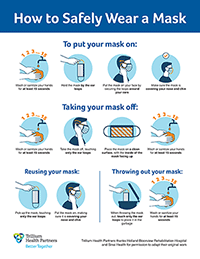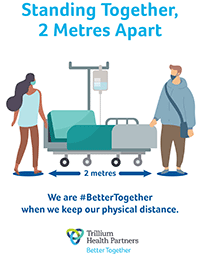COVID-19
Information for Patients and Families
COVID‑19 Vaccine
at Trillium Health Partners
What to do if you think you have COVID‑19
Self-assessment tools and health tips for you and your family
Assessment Centres
Dedicated COVID-19 testing centres for the Mississauga community
Visiting THP & Connecting with Patients
Visiting Credit Valley Hospital and Mississauga Hospital during COVID‑19
Media
Information, assets and contacts for members of the media.
Important Bulletins
Latest updates from THP on patient care services
FAQs
Frequently asked questions from our patients and community
Donate
Support your local hospital and health care workers during COVID‑19
COVID-19 Therapeutics
For the early treatment of COVID‑19
Entering Trillium Health Partners (THP) as an Essential Visitor
Who is an Essential Visitor?
Essential visitors are individuals who are designated by the patient (or substitute decision-makers of incapable patients) as persons who provide direct support to the patient (e.g., feeding, mobility, personal hygiene, cognitive stimulation, communication, meaningful connection, relational continuity and assistance in decision-making).
In addition to playing an important role in patient care, essential visitors also have a critical role in helping ensure the safety of our hospital community. The following information is intended to help educate essential visitors on proper infection prevention and control methods prior to visiting the hospital.
If you have any questions, comments or concerns, please speak with the patient's health care team.
Practicing Proper Hand Hygiene
It is important to practice proper hand hygiene while visiting the hospital. Regularly washing hands and frequently using hand sanitizer helps prevent the spread of infectious diseases, keeping everyone safe.
At minimum, hands should be cleaned with hand sanitizer when entering and exiting the hospital, before putting on and taking off your mask, before entering the inpatient unit, and before entering and after leaving the patient’s room.
The following videos demonstrate proper hand washing and hand rubbing (sanitizing) practices:
Hand washing
Hand rubbing (sanitizing)
Wearing a Mask
For the health and safety of THP patients, staff, visitors and the community, masks must be worn at all times. Visitors can wear their own 3-layered masks when in the hospital, as long as it is not soiled. A member of the Screening team is located at all hospital entrances and can also provide a mask for visitors to wear when they are in the hospital.
The following demonstrates how to properly wear, store and dispose of your mask:
Keeping a Safe Distance
While visiting THP, all visitors are required to maintain a physical distance of at least 2 metres whenever and as much as possible.
The following demonstrates what keeping a distance of 2 metres might look like:
Use of Additional Personal Protective Equipment (PPE)
Depending on the condition of the patient or the requirements of the inpatient unit being visited, the use of additional PPE (e.g., gowns, gloves, face shields) may be required. If required, education on the proper use of additional PPE will be provided by the inpatient unit’s clinical team before entering the patient room for a visit.
Learn More: Infection Control Education for Family Caregivers
McMaster University Continuing Education has launched a free online, self-paced course, Infection Prevention and Control of Caregivers and Families. This course is designed to help family caregivers acquire skills and knowledge for managing the prevention and control of infection.


